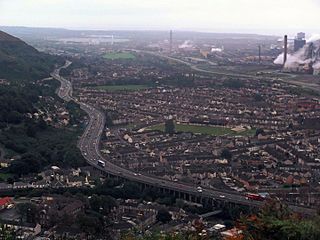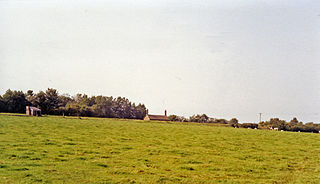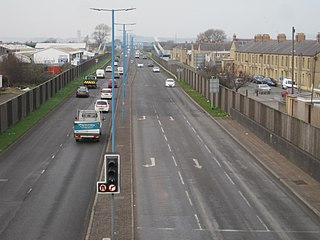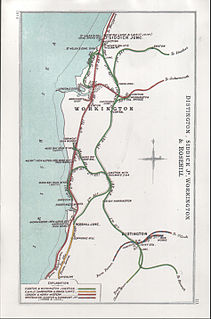
Port Talbot is a town and community in the county borough of Neath Port Talbot, Wales, situated on the east side of Swansea Bay, approximately eight miles from Swansea. The Port Talbot Steelworks covers a large area of land which dominates the south east of the town and is one of the biggest steelworks in the world but has been under threat of closure since the 1980s. The population was 37,276 in 2011.

Treherbert railway station serves the village of Treherbert in Rhondda Cynon Taf, Wales. It is the northern terminus of the Rhondda Line, 23 miles (37 km) north west of Cardiff Central.

The original Cockermouth railway station was the eastern terminus of the Cockermouth & Workington Railway. It served the town of Cockermouth, Cumbria, England.

Camerton railway station was situated next to the River Derwent on the Cockermouth and Workington Railway. It served the village of Camerton, Cumberland, England.
The Rhondda and Swansea Bay Railway was a Welsh railway company formed to connect the upper end of the Rhondda Fawr with Swansea, with the chief objective of transporting coal and other minerals to Swansea docks. It was incorporated in 1882, but at first the connection to Swansea from Briton Ferry was refused.

Altcar Rifle Range railway station was a railway station on the Liverpool, Crosby and Southport Railway, situated a third of a mile north of Hightown, Merseyside.

Abbey Town railway station was on the branch line off the Solway Junction Railway in the English county of Cumberland. The first station after Abbey Junction on the branch to Silloth on the Solway Firth, it served the village of Abbey Town. The station closed with the line to Silloth in 1964.

Abbey Junction railway station was the railway junction where the branch line to Silloth on the Solway Firth divided from the Solway Junction Railway in the English county of Cumberland.

Aberavon (Seaside) railway station was a railway station on the Rhondda and Swansea Bay line which ran from the Rhondda Valley to Swansea on the Welsh coast in the county of Glamorgan.

Aberavon Town railway station was a railway station on the Rhondda and Swansea Bay line which ran in the Rhondda Valley and Swansea area on the Welsh coast in the county of Glamorgan. Opened as Aberavon the station's name was changed twice before the emerging as Aberavon Town in 1924.
Abergwynfi railway station served the villages of Abergwynfi and Blaengwynfi in Neath Port Talbot, Wales. The station was the terminus of the line from Bridgend via Maesteg.
Aberthaw High Level railway station was a Vale of Glamorgan Railway station operated by the Barry Railway which served Aberthaw, located near the north shore of the Bristol Channel in the former Welsh county of South Glamorgan, and in the current county of Vale of Glamorgan.
Black Rock Halt was a railway station in Gwynedd, located between Criccieth and Porthmadog on the former Aberystwith and Welsh Coast Railway. It served the popular beach at Black Rock Sands beyond the headland it is named after.
St Thomas Cross Platform was a railway station used by workmen's trains on the Moor Row to Sellafield line on what is now the southeastern, Cringlethwaite, edge of Egremont, Cumbria, England.

Harrington railway station, or Church Road halt, was a railway station in Harrington, Cumbria, England. It was opened by the Cleator and Workington Junction Railway (C&WJR) on the company's Harrington Branch which connected with the Lowca Light Railway at Rosehill to provide a through route from Lowca to Workington Central and beyond.

Rosehill railway station was opened by the Cleator and Workington Junction Railway (C&WJR) on the company's Harrington Branch which connected with the Lowca Light Railway (LLR) at Rosehill to provide a through route from Lowca to Workington Central and beyond.
Jersey Marine railway station was a railway station on the Rhondda and Swansea Bay line (R&SBR) which ran from the Rhondda Valley to Swansea on the Welsh coast in the county of Glamorgan. It lay 3 miles (4.8 km) east of Swansea.
Calderpark Halt railway station or Calderpark for Glasgow Zoo (NS679625) served Calderpark Zoo opened in 1947 on the old estate of Calderpark and the Baillieston area of Glasgow, Scotland on the Glasgow, Bothwell, Hamilton and Coatbridge Railway between Shettleston and Hamilton. Glasgow Zoo closed in 2003.
Court Sart railway station served the town of Briton Ferry, Wales, from 1895 to 1935 on the Rhondda and Swansea Bay Railway.
Danygraig Halt railway station served the suburb of Dan-y-graig, in the historical county of Glamorganshire, Wales, from 1895 to 1936 on the Rhondda and Swansea Bay Railway.









